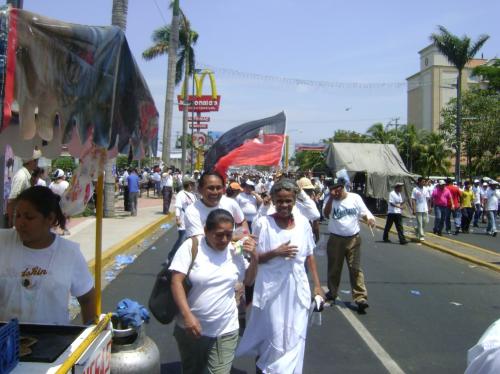The Sandinista flags are still flying
In barely 18 years, the XXI century in Latin America has seen two important political swings.
- Análisis

In barely 18 years, the XXI century in Latin America has seen two important political swings. In the past, the region saw similar changes but not so swiftly. The century began with the victory (1998) of Comandante Hugo Chávez in Venezuela. He was followed by Lula in Brazil, Kirchner in Argentina, Evo Morales in Bolivia, Correa in Ecuador, Lugo in Paraguay, Zelaya in Honduras, the Frente Amplio in Uruguay, the FMLN in El Salvador and the FSLN in Nicaragua. One must add the Cuban Revolution that celebrated over 40 years of victories. In addition, Social Democrats were installed in power in Chile, Peru, Costa Rica and the Dominican Republic. The conservative governments of Colombia, Panama and Mexico became relatively isolated. To the surprise of many, the old power balance in which the United States faced a politically divided continent subordinated to the demands of Washington, seemed to have changed.
Nevertheless, to think this was the case was to underestimate the capacity of the United States. They immediately put into action a neoliberal agenda for the region. The so-called leftist governments were not socialist, nor did they promote revolutionary policies. They all had in common a program that favoured the more economically marginalized and politically repressed sectors. The agenda of the “progressive” governments was to eradicate poverty and promote political inclusion. The prospects of development and democracy became daily offerings.
The United States did not accept these changes and mobilized all their resources to destroy the social experiments in the region. The first task was to unleash the “media war” that included psychological tactics to distort the programs of the left. The offensive consisted in declaring progressive government leaders as mentally infirm, promoting the idea that they were thieves and assassins. The most powerful media of the United States cite the Think Tanks financed by the Washington government to discredit Latin American governments. In second place, they attacked their leaders through the judicial system. Finally, they managed to overthrow, exile, arrest or eliminate the progressive government leaders.
At present, the power balance between progressives and conservatives has been reverted and the latter are governing in the majority of the countries in the region. Now it is the countries with progressive governments that are isolated. This is the case of Venezuela and Bolivia, survivors of the conservative offensive organized by Washington. Cuba continues subject to an implacable economic blockade.
Nicaragua and El Salvador are also countries submitted to the media tactics of destabilization. The case of the fatherland of Sandino deserves an in-depth study (that we shall not undertake here). All the tactics employed by the United States in the Middle East (the Arab spring), in Eastern Europe (the orange mobilizations) and in East Asia (the umbrella movement) are being applied in Nicaragua. The Sandinista government of Daniel Ortega — hand in hand with the US – made a pact with the business associations and the hierarchy of the Catholic Church, thinking that they would find a formula for governing. In addition, they committed the error of negotiating a loan with the International Monetary Fund (IMF).
This is something like a pact with the devil. Ortega achieved the loan by putting pension funds as collateral. The protest of social insurance beneficiaries was immediate. Ortega quickly cancelled the pact with the IMF. Nevertheless, the US had already had its strategy in place. Firstly, they unleashed an offensive of business leaders and the Catholic Church. Then they mobilized so-called civil society, trained, financed and armed by the US Think Tanks.
Ortega was questioned in all the media in the US, Europe and the rest of the world. Moreover, some sectors of the Latin American left, mentioned above, added to the denunciations, asking for the resignation of the president, one of the nine former Sandinista comandantes who overthrew Somoza. A Sandinista faction in opposition to the FSLN joined the most conservative sectors of Nicaragua, asking for the resignation of Ortega. This appeared as deja vu of what occurred in Honduras or Brazil.
The Lima Group of countries brought the case of Nicaragua to the OAS to denounce the Sandinista government. Their intentions failed since a large majority understood that this was a conspiracy and not an intention to resolve the conflict in the fatherland of Sandino. The FSLN needs to advance by introducing the new generations into the leadership of the country to neutralize the US and their internal enemies.
June 28 2018.
(Translated for ALAI by Jordan and Joan Remple Bishop)
- Marco A. Gandásegui, Jr. is professor of Sociology with the University of Panama and associated researcher with the Centro de Estudios Latinoamericanos Justo Arosema (CELA)
http://marcogandasegui2017.blogspot.com/
Del mismo autor
- La pandemia no es el fin del capitalismo 23/04/2020
- Hay que masificar las pruebas contra un virus clasista 19/04/2020
- ¡Qué falta hacen los Comités de Salud de J. Renán Esquivel! 09/04/2020
- La desigualdad social y la desconfianza contribuyen a la epidemia 02/04/2020
- Hacen falta más ‘pruebas’ para ‘suprimir’ el coronavirus 26/03/2020
- La crisis del capitalismo y el coronavirus 19/03/2020
- Urge una movilización general para atacar el corona-virus 12/03/2020
- Se necesita liderazgo y transparencia para enfrentar el corona-virus 05/03/2020
- EEUU veta relaciones entre Panamá y China 27/02/2020
- Roberto Arosemena, sus ideas perduran y sus luchas continúan 20/02/2020
Clasificado en
Clasificado en:
Debate izquierdas
- Umberto Mazzei 06/09/2021
- Umberto Mazzei 06/09/2021
- Sergio Rodríguez Gelfenstein 17/06/2021
- Andrés Kogan Valderrama 17/06/2021
- María José Olguín 11/05/2021








